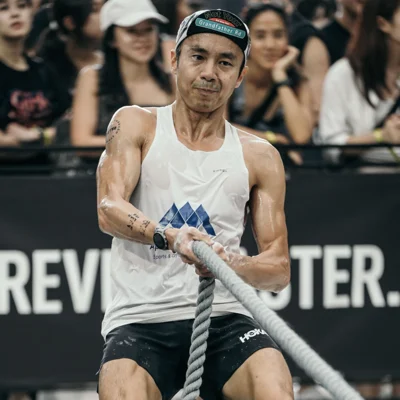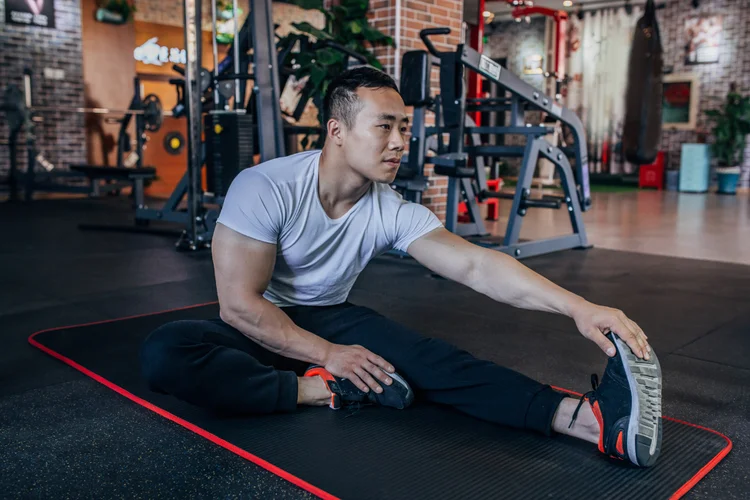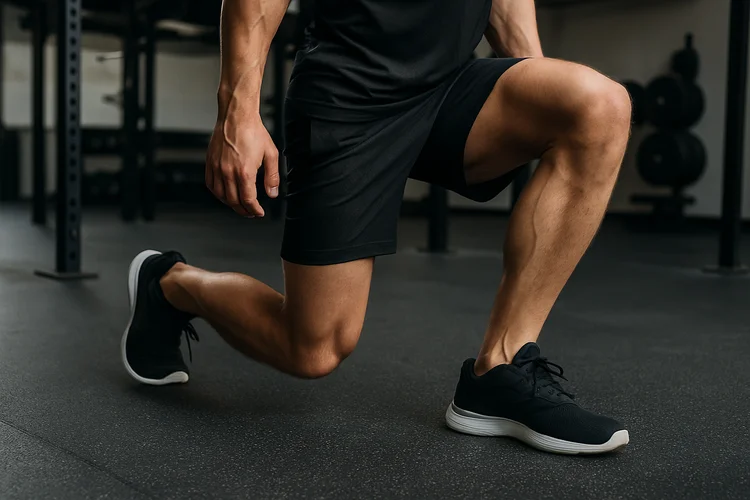7 Tips for HYROX Injury Prevention
Information reviewed by: Dr. Foo Gen Lin | Last updated: Oct 29, 2025
HYROX combines endurance and functional strength stations, placing intense stress on joints and muscles. Dr Foo delivers expert assessment and tailored prevention strategies to protect you from injury and optimise performance.
MBBS (University of London) | MMed (Ortho) | FRCSEd (Ortho) | FAMS (Ortho)


What Is Hyrox and Why Do Injuries Happen?

Hyrox©
is a global fitness competition that challenges participants with a mix of running and
functional workouts. Each event combines endurance and strength stations such as sled
pushes, lunges, rowing and burpees, often performed back to back when fatigue sets in.
Because of this intensity, it is not uncommon for athletes to experience injuries from
overuse, poor technique or simply pushing too hard without enough preparation and
recovery. Knowing why these issues happen is the first step to training smarter
and staying injury free.
In this article, we will explore the most common Hyrox injuries and practical strategies to
prevent them.
What Are Common Hyrox Injuries?
The most common Hyrox injuries involve the lower limbs, shoulders and back due to the combination of endurance and strength exercises. These injuries often overlap with issues seen in both endurance and strength sports.
| Common Injuries | Description | Common Causes |
|---|---|---|
| Knee pain and tendinopathy | Irritation of the knee tendons, often causing pain during squats, lunges or running | Repetitive lunges, squats and running |
| Achilles tendinopathy and calf strains | Overuse or tearing of the Achilles tendon or calf muscles, leading to stiffness or soreness in the lower leg | Sprinting and repeated jumping movements |
| Shoulder strain or rotator cuff irritation | Inflammation or small tears in the shoulder muscles or tendons, resulting in pain with lifting or overhead movement | Overhead or pulling exercises such as wall balls and sled pulls |
| Lower back strain | Injury to muscles or ligaments in the lumbar spine, often causing localised pain or stiffness | Lifting, carrying and posture changes under fatigue |
| Shin splints or stress reactions | Pain along the shin bone from repetitive impact, sometimes progressing to stress fractures | High running volume on hard surfaces |
| Plantar fasciitis | Inflammation of the tissue under the heel, producing sharp pain with the first steps or prolonged activity | High running mileage, poor footwear and impact loading |
| Hip flexor strain | Tightness or small muscle tears at the front of the hip, leading to discomfort when running or lunging | Repetitive lunges, sled pushes and running mechanics |
| Wrist pain or sprains | Irritation or ligament strain around the wrist joint, causing pain with gripping or weight-bearing | Rowing, farmer’s carries and repeated gripping movements |
How Can You Prevent Injuries During Hyrox Training?
Preventing Hyrox injuries requires a structured approach that balances training intensity, recovery and technique. The goal is not just to train harder, but to train smarter so your body adapts safely to the unique demands of the event.
1. Warm-up and Mobility
A proper warm-up is important because it prepares the body for exercise and lowers the risk of injury. Hyrox involves stations that demand sudden bursts of power, such as sled pushes, burpees and wall balls, which place stress on multiple muscle groups at once.

Priming the body before these movements helps improve performance and reduces the chance of
strains or overuse issues.
An effective warm-up should include dynamic stretches, activation drills and
mobility exercises to raise blood flow, loosen tight areas and prepare movement
patterns. Examples include hip openers to improve lunge depth, shoulder rotations to support
overhead work and light jogging to prepare for the running segments.
2. Progressive Training Load
Sudden increases in training volume or intensity are a common cause of overuse
injuries
in Hyrox preparation. A gradual build-up is safer, giving muscles, tendons and joints time
to adapt to higher demands.
Aim to increase running mileage and functional exercise load by no more than 10 to 15
percent each week to reduce injury risk while still making steady progress.
3. Technique Refinement
Many Hyrox injuries occur not only from training volume but also from
poor movement quality when fatigue sets in.
Each station places specific demands on the body, such as the pushing power needed for
sleds or the repetitive overhead
motion involved in wall balls. Mastering correct technique for these movements helps reduce
strain on joints and muscles.
For a guided approach, especially if you are starting out, consider structured
training classes or professional coaching to reinforce proper form as your
workload increases.

4. Strength and Stability Training
Building strength in the major muscle groups helps the body tolerate the repeated,
high-intensity demands of Hyrox.
Strong hips, glutes and hamstrings reduce strain on the knees during running, squats and lunges.
Core muscles, including the abdominals and lower back, stabilise the trunk and protect the spine
during sled pushes and carries.
Shoulder and upper back strength support overhead movements such as wall balls and rowing.
Incorporating functional work like single-leg squats, planks and rotational core drills
improves balance, posture and resilience against injury.
5. Use Appropriate Equipment and Gear

The right gear can support performance and reduce injury risk in both training and
competition, while the wrong gear can increase stress on joints and raise the
chance of injury.
Well-cushioned running shoes help absorb impact on the knees and shins, while supportive
cross-training shoes provide stability during strength-based stations. Some may also benefit
from compression wear or joint braces for added support under repetitive load.
Paying attention to footwear, grip and training surfaces is a practical way to minimise
unnecessary strain.
6. Adequate Recovery
Recovery is just as important as training because it allows muscles, tendons and joints to
repair, adapt and grow stronger after repeated stress. Without sufficient recovery, the
body remains in a fatigued state, which increases the risk of overuse injuries and reduces overall
performance.
Regular rest days give the body time to heal, while alternating harder sessions with lighter ones
prevents overtraining. Quality sleep supports tissue healing and energy restoration, and balanced
nutrition helps fuel recovery. Active methods such as swimming, cycling or stretching can further
reduce fatigue and prepare the body for the next session.
7. Listen to Early Warning Signs
Early signs of overuse include small niggles, persistent tightness, soreness that
does not settle with rest, or discomfort that worsens during activity. These signals suggest the
body is struggling to cope with current training demands.
Addressing them promptly with load adjustments, physiotherapy guidance or targeted
corrective exercises can stop minor issues from developing into more serious injuries,
including acute problems such as sprains and strains as well as chronic conditions like
tendinopathy.
This proactive approach also supports long-term performance by keeping the body prepared for the
demands of training and competition.
Conclusion: Staying Injury-Free in Hyrox

Preparing for Hyrox is as much about protecting your body as it is about pushing
your
limits. The combination of running and strength stations is demanding, but with
the right approach you
can train hard while staying injury-free.
Injury prevention is not about holding back but about
preparing wisely. With these strategies, you can approach training and competition feeling
stronger,
more confident and ready to perform.
At Apex Sports Clinic, we provide sports performance and fitness
testing along with personalised injury-prevention strategies to support and optimise your
training.
Our sports doctors are athletes themselves who have HYROX experience and can support you in
preparing
and performing at your best.
Every patient deserves a treatment plan tailored to their needs. We start with non-surgical approaches before considering more invasive interventions.
Find a Sports Injury Doctor Near Me
Apex Novena
admin@apexsportsclinic.sg
101 Irrawaddy Rd, #18-12 Royal Square Medical Centre, Singapore 329565
Nearest MRT: NS20 Novena
Apex East Coast
admin@apexsportsclinic.sg
112 E Coast Rd, #03-03/04 i12 Katong, Singapore 428802
Nearest MRT: TE26 Marine Parade
Why Do Patients Choose Apex Sports Clinic?
Sports Doctor in Singapore: Personalised & Affordable Care
Progressive Treatment Philosophy
We prioritise personalised, non-invasive solutions, progressing to specialised treatments, including surgery, only when needed for more effective and targeted care.
Holistic Patient-Centred Care
From diagnosis to rehabilitation, we provide comprehensive and seamless care for a wide range of orthopaedic conditions.
Specialist in Sports Orthopaedics & Injury Management
We combine expert injury management with a proactive approach to maintaining your body's strength and function, so you can recover fully and perform at your peak.
Patient Journey
1 . Schedule Your Appointment

2 . Expert Diagnosis & Consultation

3 . Customised Treatment Plan

Schedule an Appointment

Our Insurance Partners






Frequently Asked Questions (FAQs)
The best way to prevent injury when training for HYROX is to follow a structured programme that balances progressive load, correct technique, strength training, recovery and appropriate gear. Each of these factors helps reduce unnecessary stress on the body and supports consistent performance. If you are new to HYROX or uncertain about your training approach, seeking professional guidance or structured coaching can be helpful.
Energy gels are not essential for HYROX, but some athletes use them to maintain carbohydrate intake during the event, particularly if their race pace is high or they are prone to energy dips. Others rely on pre-race meals and hydration instead. Whether gels are helpful depends on your individual tolerance, nutrition habits and competition strategy.
To get strong for HYROX, focus on functional strength training that targets the hips, glutes, hamstrings, core, shoulders and upper back, as these muscles support both running and station movements. Combining compound lifts, bodyweight drills and stability work prepares the body to handle high-intensity effort and repetitive loading. If you are new to structured strength training, you might want to consider professional coaching to ensure proper technique and progression.
Creatine is widely considered useful for high-intensity sports because it supports repeated short bursts of power, which may benefit HYROX exercises such as sled pushes and rowing. However, individual response and tolerance vary, and not all athletes find it necessary for performance. If you are considering supplementation, it is advisable to consult a sports doctor or dietitian to determine whether creatine suits your overall health and training plan.
Strengthening muscles for HYROX helps prevent injuries by improving stability, supporting joints and increasing the body’s ability to handle repetitive high-intensity movements. Strong glutes, hamstrings and hips protect the knees during running and lunges, while core and shoulder strength stabilise the trunk during sled pushes and overhead stations. This balanced strength lowers the chance of overload on vulnerable areas and makes injuries less likely.
Supplements for HYROX are not essential but some athletes use protein powder, electrolytes or creatine to support recovery, hydration and power output. The choice depends on individual nutrition habits, tolerance and competition demands. A balanced diet usually provides most needs, but supplementation can help fill specific gaps. If you are unsure, it may be beneficial to consult a sports doctor or dietitian before starting any supplement to ensure it fits your training and health goals.
The body parts most commonly injured in HYROX training are the knees, ankles, shoulders and lower back, as these areas take on repeated stress from both running and functional exercises. Knee pain and Achilles problems often result from the high running volume, while shoulder strains are linked to overhead movements such as wall balls and sled pulls. The lower back is also vulnerable due to lifting, carrying and posture changes under fatigue.
In HYROX, the wall ball weight varies by category. For the Open race, women use a 4-kilogram ball and men use a 6-kilogram ball. In the Pro race, women throw a 6-kilogram ball and men throw a 9-kilogram ball. This station comes at the end of the event, when fatigue is high, and requires repeated overhead throws, making proper technique and shoulder strength essential to reduce strain and injury risk.
HYROX involves a total of 8 kilometres of running, broken into eight 1-kilometre segments between each functional workout station. The runs are spread across the event rather than completed all at once, which means endurance is tested under fatigue. Training should therefore prepare the body to run at pace while managing transitions into and out of demanding strength exercises. This combination increases both cardiovascular and muscular load.

